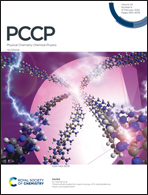Two-dimensional CdS/SnS2 heterostructure: a highly efficient direct Z-scheme water splitting photocatalyst†
Abstract
A desired water splitting photocatalyst should not only possess a suitable bandgap and band edge position, but also host the spontaneous progress for overall water splitting without the aid of any sacrificial agents. In this work, we propose a two-dimensional CdS/SnS2 heterostructure (CSHS) as a possible water splitting photocatalyst by first-principles calculations. The CSHS enhances the absorption of visible and infrared light, and the type-II band alignment guarantees the spatial separation of the photoinduced carriers. The induced built-in electric field across the CSHS interface efficiently separates the photoexcited carriers and extends their carrier lifetimes. All these properties make the CSHS a direct Z-scheme system with the hydrogen and oxygen evolution reactions occurring, respectively, at the CdS and SnS2 layers. More encouragingly, the introduction of a S-vacancy into SnS2 could effectively lower the overpotential of the oxygen evolution reaction, thus ensuring the overall water redox reaction to be achieved spontaneously under light irradiation. Our findings suggest that the CSHS is a promising water splitting photocatalyst.



 Please wait while we load your content...
Please wait while we load your content...